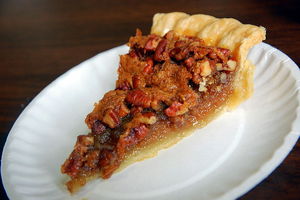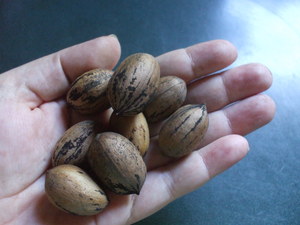If you have a pecan tree growing in your yard that you didn’t plant, you can probably thank Mother Nature or one of nature’s helpers. You can pull out the small seedling trees, cut them down with the lawnmower or dig the small seedling out of the ground and transplant it in another area. Instead of spending your money on a pecan tree at the nursery, this will save you some extra cash for other things. But if you buy your pecan tree at the nursery, find one that is resistant to scab, which is a fungal disease that occurs in damp weather. The UGA Cooperative Extension in Hall County recommends these varieties: Eliott, Stuart, Curtis, Gloria Grande and Summer. The best time to transplant the small pecan trees is in February or early March.
Before you dig a hole to plant the pecan tree, you will need to choose the right location. There should be 50 to 80 feet separating the pecan tree with other trees or buildings. Pecan trees need room to grow.
The best time to transplant your pecan tree is late in the month of February or early March. Once you find the right location, full of sun and away from other buildings and trees, you need to prepare the site.
Prepare the Area
Remove the vegetation in a 5 to 6 foot diameter circle. If you don’t, the weeds and grasses will rob the pecan tree from the much-needed moisture it needs to grow.
Dig a hole in the center of the cleared area for the pecan tree. It should be 3 feet wide by 3 feet deep. Scuff the sides and bottom of the hole with the edge of your spade or shovel. If the pecan tree is in a container, then dig the hole so it is three times as big as the container.
Fill the hole with water. Allow the water to drain into the soil naturally. It may take several hours for this to happen. After the water has soaked into the soil, it is time to either dig your pecan tree out of the ground, or remove it from the container.
Dig the Pecan Tree Out of the Ground
If the pecan tree is growing in the ground, dig it out after the water has drained out of the planting hole. Position your spade about a foot away from the trunk and insert the spade into the ground. Do this all the way around the pecan tree. Pry the pecan’s rootball out of the ground, being careful to keep the rootball intact. Lift the rootball out of the hole and place it into a box, or cart so you can transport it easily to the new planting area.
Remove the pecan tree from the container, keeping the rootball intact. Examine the rootball and if you see any roots growing along the outside, loosen them with your fingers.
Transplanting the Pecan Tree
Place the rootball in the center of the hole. The top of the rootball should be slightly higher than the surrounding soil. It will settle down and be level with the soil when you water it. Make sure the pecan tree is centered and horizontally straight in the hole. Do not bury the pecan tree any deeper than it originally grew. If some of the soil has come off from around the tree trunk, you can still determine the planting depth by looking at the trunk and finding the dark area. This tells you how deep the pecan tree was in the soil.
Fill in the hole around the rootball with soil, until the hole is half-full. Gently firm the soil around the rootball, and then finish filling the hole. Tamp the soil with your hands or foot.
Watering
Water the small pecan tree thoroughly. This will remove any air pocket in the soil. Air pockets can cause the tree to sink deeper into the hole and it can cause the tree to die. Keep the pecan tree watered during the first two years until it is established and the roots are reaching deep into the soil. The soil should be moist, but never soggy or the pecan tree will rot and die.
Mulch
Add organic mulch around the pecan tree, keeping it 1 to 2 inches away from the trees bark. It should be 4- to 6 inches deep. Mulch helps the soil to retain moisture content and it prevents weeds from growing.
Fertilizing
For the first year, do not fertilize your pecan tree or you may burn the root system. When your pecan tree grows 2 to 4 feet tall by June, then you can safely fertilize. Apply 1 lb, of 5-10-15 fertilizer in an area that is 25 square feet around the tree.
Some pecan trees do not produce nuts that taste like their parent. They may also have fewer nuts than the parent tree.
Sources:
UGA Cooperative Extension in Hall County: Hall County Forage Field Day
The University of Georgia College of Agricultural and Environmental Sciences: Early Planting Decisions Important to Pecan Trees
“Tree Care” John M. Haller 1959






